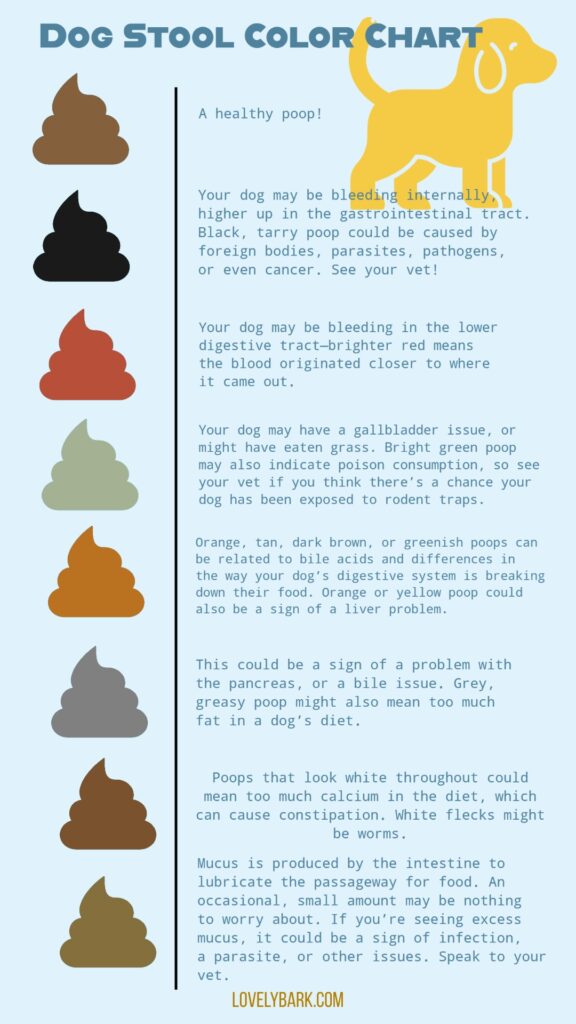Table of Contents
Understanding Blood in Dog Poop
Discovering blood in your dog’s stool can be alarming, but it’s essential to understand that it can be caused by several factors, ranging from mild and treatable to more serious conditions that require immediate veterinary attention. The key factors to consider are the amount of blood, the color of the blood, and any accompanying symptoms. By observing these factors, you can better assess the severity of the situation and take appropriate action.
Is Blood in Dog Poop an Emergency?
The presence of blood in your dog’s poop doesn’t always indicate an emergency. If your dog is experiencing constant bloody diarrhea, appears lethargic, or is vomiting, it is crucial to seek immediate veterinary care. On the other hand, if your dog has only passed a small amount of blood and is otherwise behaving normally, a call to your primary veterinarian may suffice. It is important to provide your vet with detailed information, such as the color of the blood and any unusual symptoms, to aid in their assessment.Differentiating Bright Red Blood and Black, Tarry Blood
When examining your dog’s poop, it’s essential to distinguish between two types of blood: bright red blood and black, tarry blood. Bright red blood in your dog’s stool, known as hematochezia, indicates that the bleeding is occurring in the lower digestive tract or colon. This type of bleeding is typically associated with specific conditions and can be seen on fully formed stools or loose stools. It is crucial to monitor the frequency and consistency of your dog’s poop, as consistent bleeding or large amounts of blood can signal a more serious problem. Black, tarry blood in your dog’s stool, referred to as melena, suggests that the bleeding is originating from the upper digestive tract. Melena occurs when blood has been digested or swallowed, indicating an issue in the stomach, small intestine, or other upper gastrointestinal areas. It is important to note any changes in your dog’s poop color or appearance and promptly consult your veterinarian.
Causes of Bright Red Blood in Dog Stool
Bright red blood in your dog’s stool can have various causes, ranging from mild to severe. While a single streak of red blood may be insignificant, consistent bleeding or large amounts of blood require attention. Here are some common causes of bright red blood in dog stool:Colitis
Inflammation of the colon, known as colitis, can lead to the presence of bright red blood in your dog’s stool. Colitis can be caused by various factors, including dietary changes, allergies, infections, or inflammatory bowel disease.Parasites
Certain parasites, such as hookworms, can cause intestinal irritation and lead to blood in your dog’s stool. Regular deworming and preventive measures can help reduce the risk of parasite-related issues.Trauma
Injury or trauma to the gastrointestinal tract can result in bleeding. This can occur due to ingestion of sharp objects, rough play, or accidents. It is important to monitor your dog’s behavior and environment to minimize the risk of trauma.Toxins
Exposure to certain toxins or ingestion of poisonous substances can cause gastrointestinal irritation and bleeding. It is crucial to keep your home environment safe for your dog and be mindful of potential hazards.Inflammatory Bowel Disease
Inflammatory bowel disease (IBD) is a chronic condition characterized by inflammation in the gastrointestinal tract. It can lead to various symptoms, including bloody stool, diarrhea, and weight loss. Proper diagnosis and management are essential to control the condition.Anal Sac Infections or Impactions
Infections or impactions of the anal sacs can cause discomfort and lead to blood in your dog’s stool. Regular anal gland expression or veterinary treatment may be necessary to address these issues.
Causes of Black, Tarry Stools in Dogs
Black, tarry stools, or melena, indicate bleeding higher up in the digestive tract. Understanding the underlying causes can help determine the appropriate course of action. Here are some potential causes of black, tarry stools in dogs:Infections
Bacterial or viral infections, such as parvovirus, can lead to gastrointestinal inflammation and bleeding. Prompt veterinary care is crucial to manage these infections effectively.Parasites
Certain intestinal parasites, including worms, coccidia, and giardia, can cause gastrointestinal irritation and result in melena. Regular deworming and preventive measures help reduce the risk of parasite-related issues.Inflammatory Disorders
Inflammatory conditions affecting the stomach, small intestine, or other parts of the gastrointestinal tract can lead to black, tarry stools. These disorders require proper diagnosis and treatment to manage symptoms effectively.Ulcers
Ulcers in the stomach or upper gastrointestinal tract can cause bleeding and result in melena. Identifying and addressing the underlying cause of ulcers is essential for proper management.Tumors
In some cases, gastrointestinal tumors can cause bleeding and lead to the presence of black, tarry stools. Early detection and intervention are crucial for improving treatment outcomes.Foreign Bodies and Trauma
The ingestion of foreign objects or trauma to the gastrointestinal tract can cause bleeding and result in melena. Avoidance of hazardous objects and careful supervision can help prevent these situations.Kidney Failure
Kidney failure can lead to various complications, including gastrointestinal bleeding and melena. Proper management of kidney disease is essential to minimize associated risks.Exposure to Toxins
Certain toxins or ingestion of poisonous substances can cause gastrointestinal irritation, ulcers, and bleeding. Preventive measures and prompt veterinary care are necessary in cases of toxin exposure.Addison’s Disease
Addison’s disease, a hormonal disorder affecting the adrenal glands, can lead to gastrointestinal symptoms, including melena. Timely diagnosis and appropriate treatment are vital for managing this condition.Liver Disease
Liver disease can affect the proper functioning of the gastrointestinal system and lead to melena. Identifying and addressing the underlying liver condition is crucial for effective management.Pancreatitis
Inflammation of the pancreas, known as pancreatitis, can cause gastrointestinal symptoms, including melena. Proper diagnosis and management of pancreatitis are essential to alleviate symptoms.Hormonal Imbalances
Hormonal imbalances, such as those seen in Cushing’s disease or hypothyroidism, can affect the gastrointestinal system and lead to melena. Proper diagnosis and treatment of the underlying hormonal disorder are necessary.Clotting Disorders
Conditions that interfere with normal blood clotting, such as von Willebrand’s disease or hemophilia, can result in bleeding throughout the body, including the gastrointestinal tract. Timely intervention and proper management are crucial for individuals with clotting disorders.Reaction to Medications
Certain medications, such as non-steroidal anti-inflammatory drugs (NSAIDs), can cause gastrointestinal irritation, ulcers, and bleeding. If your dog is on medication and experiencing melena, consult your veterinarian for appropriate adjustments to the treatment plan.
Other Symptoms to Watch Out For
While blood in your dog’s stool is a concerning sign, it’s important to be aware of other symptoms that may indicate more serious conditions. Keep an eye out for the following signs:Changes in Appetite
A sudden loss of appetite or significant changes in your dog’s eating habits can be indicative of an underlying health issue. Consult your veterinarian if your dog’s appetite changes persist.Changes in Activity Levels
Unexplained lethargy or a significant decrease in your dog’s energy levels may indicate an underlying health problem. If your dog is unusually inactive or appears weak, seek veterinary attention.Changes in Attitude or Behavior
Notice any sudden changes in your dog’s behavior or temperament, such as increased irritability, aggression, or depression. These behavioral changes can be associated with underlying health issues and should be addressed by a veterinarian.Vomiting
Frequent or persistent vomiting, especially when accompanied by blood in the stool, can be a sign of serious gastrointestinal issues. Seek veterinary care if your dog is experiencing vomiting along with bloody stool.Weakness
If your dog displays signs of weakness, such as difficulty standing, lack of coordination, or collapsing, it may indicate a serious health problem. Immediate veterinary attention is necessary in such cases.Blood in the Urine
The presence of blood in your dog’s urine, along with bloody stool, may indicate a systemic issue affecting multiple organs. It is crucial to consult a veterinarian for a comprehensive evaluation.Difficulty Breathing
Labored breathing or shortness of breath can be a sign of a severe underlying condition. Contact your veterinarian immediately if your dog is experiencing difficulty breathing. If your dog exhibits any of these symptoms for the first time and is on any medication, stop the medication immediately and seek veterinary attention.Treatment Options for Dogs with Blood in Their Stool
The treatment for bloody stool in dogs depends on the underlying cause, severity of symptoms, and overall health of the dog. It is essential to consult a veterinarian for a proper diagnosis and treatment plan. Here are some potential treatment options:Veterinary Examination and Diagnostic Tests
To determine the cause of the bleeding, your veterinarian may perform a thorough physical examination and recommend diagnostic tests such as fecal examination, blood work, imaging (x-rays or ultrasound), or endoscopy. These tests help identify the underlying condition and guide appropriate treatment.Treating Underlying Conditions
The treatment plan will vary depending on the specific condition causing the blood in your dog’s stool. In cases of gastrointestinal inflammation or infections, medications such as antibiotics, anti-inflammatory drugs, or probiotics may be prescribed. Dietary changes, including a bland diet, may also be recommended to help alleviate symptoms.Fluid Therapy and Supportive Care
If your dog is dehydrated or experiencing severe symptoms, fluid therapy may be necessary to restore hydration and electrolyte balance. In some cases, hospitalization may be required for close monitoring and administration of intravenous fluids.Surgical Intervention
In situations where foreign bodies or tumors are causing gastrointestinal bleeding, surgical intervention may be necessary. Your veterinarian will discuss the available options and recommend the most appropriate course of action.Follow-up Care and Monitoring
After initiating treatment, regular follow-up visits and monitoring may be required to assess your dog’s progress and make any necessary adjustments to the treatment plan. It is crucial to follow your veterinarian’s instructions and provide any prescribed medications as directed.
When to Seek Emergency Veterinary Care
While some cases of blood in a dog’s stool may not require immediate veterinary attention, certain situations warrant emergency care. Contact your veterinarian or an emergency veterinary clinic if you observe the following:- Profuse bleeding or large amounts of blood in the stool
- Continuous bloody diarrhea or vomiting
- Weakness, lethargy, or collapse
- Signs of shock, such as pale gums, rapid breathing, or a rapid heart rate
- Inability to urinate or blood in the urine
- Severe abdominal pain or distention
- In these situations, prompt veterinary care is essential to assess and manage potentially life-threatening conditions.
Preventive Measures for Dog Stool Issues
While some causes of blood in your dog’s stool cannot be prevented, there are steps you can take to reduce the risk of gastrointestinal issues. Here are some preventive measures to consider:Proper Diet and Nutrition
Provide your dog with a well-balanced diet that meets their nutritional needs. Avoid sudden dietary changes, as they can lead to gastrointestinal upset. If you need to transition your dog to a new food, do so gradually over a span of several days to minimize digestive disturbances.Regular Exercise
Regular exercise helps maintain a healthy digestive system and promotes overall well-being. Engage your dog in daily physical activities that are appropriate for their breed, age, and health condition.Regular Veterinary Check-ups
Schedule regular check-ups with your veterinarian to monitor your dog’s overall health and detect any potential issues early on. Routine fecal examinations and preventive deworming are important aspects of maintaining your dog’s gastrointestinal health.Avoiding Harmful Substances
Keep your home environment free of potential hazards and toxic substances. Be cautious with household cleaners, certain plants, human medications, and any other items that can be harmful if ingested by your dog.Supervision and Training
Supervise your dog during outdoor activities to prevent them from ingesting foreign objects or substances that may cause gastrointestinal issues. Proper training helps discourage behaviors such as scavenging or eating inappropriate items.
Conclusion
The presence of blood in your dog’s stool can be a concerning sign, but it’s important not to panic. By understanding the possible causes, observing accompanying symptoms, and seeking veterinary care when necessary, you can ensure the best possible outcomes for your furry companion. Regular monitoring of your dog’s poop and awareness of any changes in color, consistency, or frequency can provide valuable insights into their overall health. Remember, early detection and appropriate treatment are key to maintaining your dog’s well-being.”FAQs”
What happens if dog poops blood ?
If your dog is pooping large amounts of blood or is having constant bloody diarrhea and appears lethargic or is vomiting, you should take them to the nearest emergency vet right away. If your dog has pooped a small amount of blood and is otherwise acting perfectly normal, a call to your primary vet should suffice.
What is normal dog poop color ?
If you discover any changes in your pup's normal routine, talk to a veterinarian. Dog poop should be chocolate brown. If your pup is eating food with added colours in it, some of these may also come through in your dog's poop.
What to do when dog poops blood ?
Some of the more common causes of bloody stool in dogs: Colitis (inflammation of the colon) Parasites, such as hookworms. Trauma.
What to do dog poops blood ?
If your dog is pooping large amounts of blood or is having constant bloody diarrhea and appears lethargic or is vomiting, you should take them to the nearest emergency vet right away. If your dog has pooped a small amount of blood and is otherwise acting perfectly normal, a call to your primary vet should suffice.
How often should a healthy dog poop ?
Most adult dogs poop once a day on average, although for some dogs, two or three times per day is still considered normal. Puppies, on the other hand, may need to go much more often—sometimes as much as five times a day or more.
What dog eat poop ?
If your dog is eating poop, it could be for a number of reasons, including anxiety, attention, isolation, confinement or inappropriate association with food, according to the American Kennel Club.
What if dog poops blood ?
But blood in your dog's stool can be caused by a wide range of different things. Common reasons for a dog pooing blood include food allergies, constipation, eating something unsuitable, bacterial or viral infection, colitis, or injury
How much do dogs poop ?
Some dogs poop more than others, simply because that's just the way they are. But a good rule of thumb is that dogs should poop at least once a day. Some may poop up to five times, and others in between. So if your dog poops 3 times a day, that's fine too.
How to deal with dog diarrhea ?
One of the best dog diarrhea home remedies is rice water: Fasting your dog allows their GIT to rest and recover from whatever irritation it has received. During the fast, make sure your dog has plenty of rice water to drink. (Rice water is the creamy liquid that results from boiling white rice in water.)
What causes dog to poop blood ?
Bloody stools in dogs can be caused by many different things, including infections, parasites, or cancer. If your dog is pooping blood, the best thing to do is call your vet for advice.
How much poop is too much for a dog ?
If your dog is a consistent once-a-day pooper and suddenly starts pooping three or four times a day, there's a reason behind it. It could be as simple as a change in your dog's diet or exercise schedule, but it could also be a sign of a health problem that needs to be addressed.


